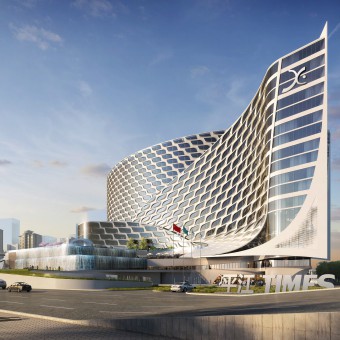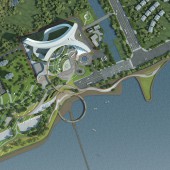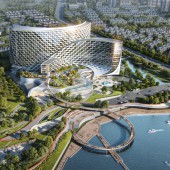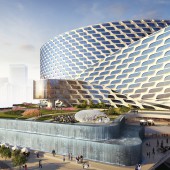DESIGN NAME:
Pingjiang Times
PRIMARY FUNCTION:
Mixed Use
INSPIRATION:
Our design strategy was inspired by the movement and flow of water. Just as the rain droplets collide with the smooth surface of water, forming a series of concentric circles that combine and overlap one another, the programmatic building elements are expressed as arching legs that combine and overlap each other. The concentric circular geometry continues through the landscape forms that extend throughout the site and tie it to the significant role that water plays in this region of China.
UNIQUE PROPERTIES / PROJECT DESCRIPTION:
The Pingjiang Times Project is an urban complex integrating a high-end hotel, retail shopping mall, serviced apartments, and office space. Inspired by the movement and flow of water, the building shape and façade system are created by curves that overlap and continued. Through the landscape design of the project, the project seamlessly interfaces with the surrounding context along the river, making the project an important link connecting the inland and waterfront landscapes of the city.
OPERATION / FLOW / INTERACTION:
To better utilize the narrow site and great view of the lake, building function are placed in a layered X shape, where hotel is in the front and has a single loaded corridor to give all the room a lake view. An internal retail street was arranged under the X shape tower to truly active the whole site.
PROJECT DURATION AND LOCATION:
The project is located in the Jiangwan area of Hangzhou. Hangzhou has benefited from the convenience of the Beijing-Hangzhou Grand Canal and the trade port, as well as its own developed silk and grain industries. Historically, it was an important commercial distribution center. Qiantang River is the base of the Jiangwan area, and has benefit people and community in the region for thousands of years. Transforming its functions, carrying the dream of "developing across rives" to "supporting the development of rivers" is important.
FITS BEST INTO CATEGORY:
Architecture, Building and Structure Design
|
PRODUCTION / REALIZATION TECHNOLOGY:
This mixed-use project is aimed not only elevate the condition inside the site by active commercial street and rich landscape platform, but also bring life to surrounding area. By proposing a tunnel for the main road between the site and river, it creates a separation of pedestrian and vehicles as well as series green platform and trails for people to engage with the environment.
SPECIFICATIONS / TECHNICAL PROPERTIES:
The gross area of the whole project is 80,705 sqm. Building height limit is 80 meters. It includes a 250-room hotel, a 14,000 sqm commercial center and a 34,397 sqm service apartment. And the site includes an existing pump station.
TAGS:
Mixed Use, Water Front, Hotel Façade, Curved Building
RESEARCH ABSTRACT:
Since the project site is quiet small and narrow compare to the mixed use program given, we looked into the different strategy of the masterplan and studied the street scale on the lower commercial center. What we find out is that different from multi-towers and big black box for commercial center on the podium levels, it is a nice experience that open up a street under towers and create a pedestrian-friendly retail street that people could easily shopping and walk through from the east to the west of the site. It makes all the area on the site being active day and night.
CHALLENGE:
Building façade is inspired by water waves and scripted by grasshopper. The ratio of the window and solid have been studied carefully to give a comfortable sense from hotel interior. Another change is how to utilize and active the narrow site cut by existing pump station and create extensive connection to the lake front. The design separates vehicle and pedestrian loop and create a big landscape platform on top of existing pump station which extend to the lake to encourage social interaction of local citizen and traveler and benefit local environment.
ADDED DATE:
2021-03-13 07:00:46
TEAM MEMBERS (4) :
Jun Ding, Robert Du, Jiajia Lin and Michael Strohmer
IMAGE CREDITS:
Jun Ding and Michael Strohmer, 2020.
|










